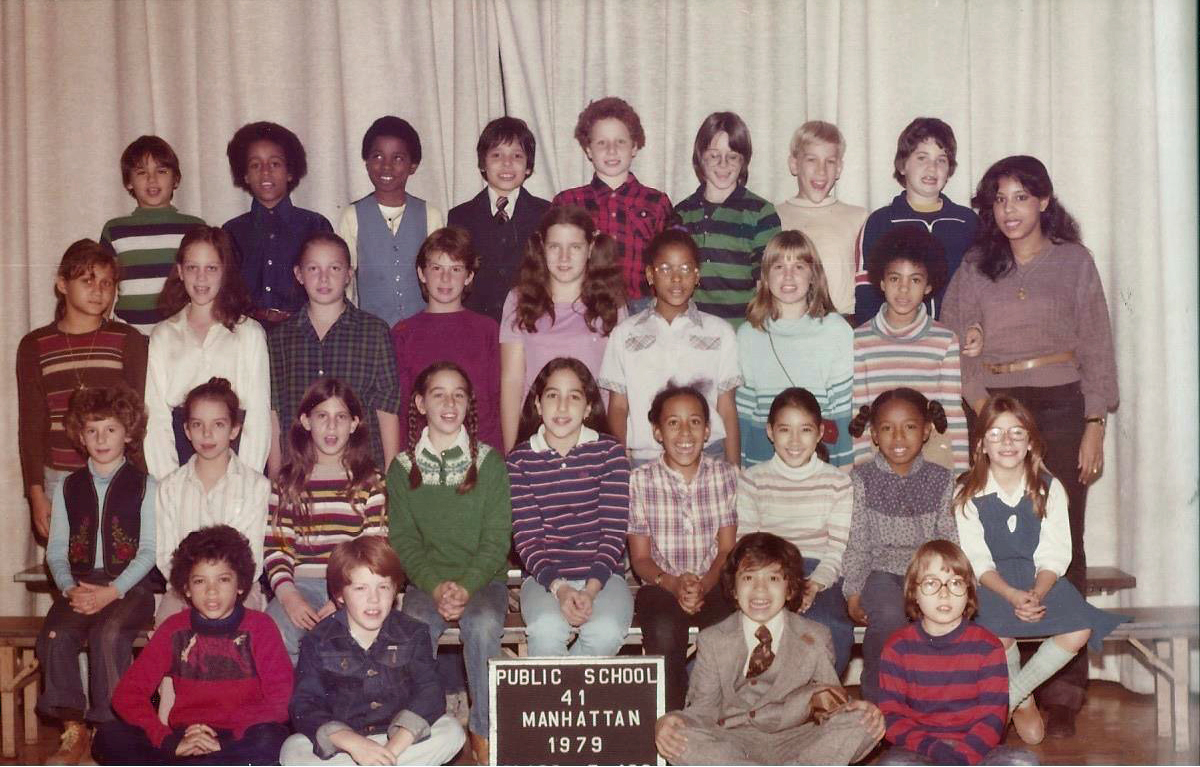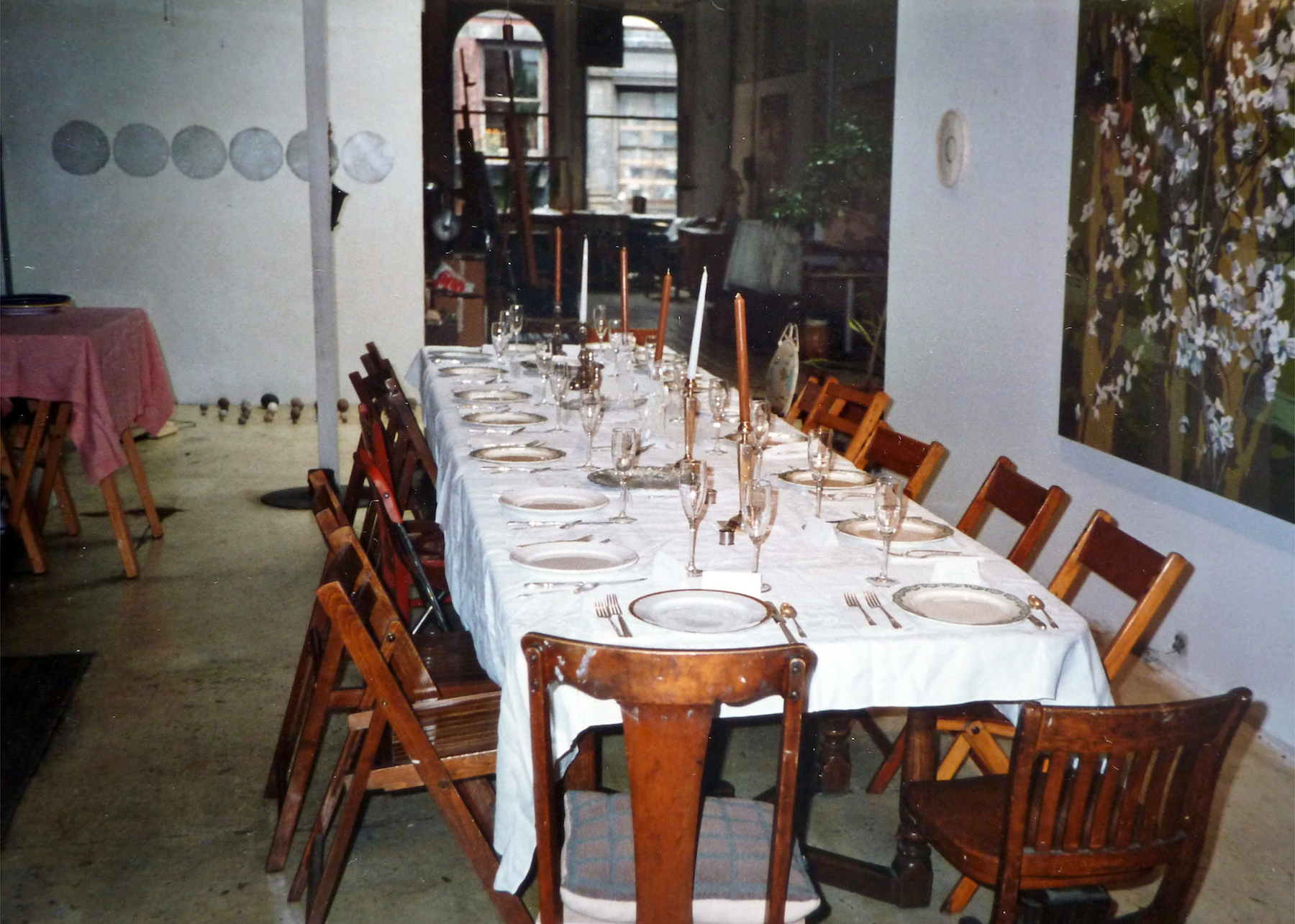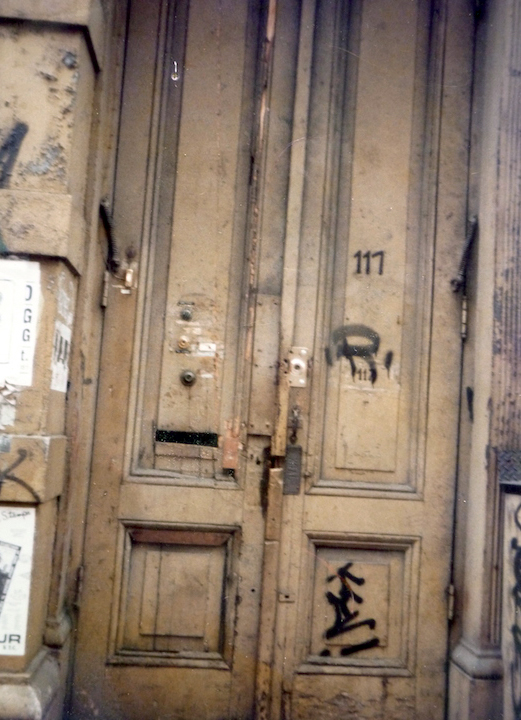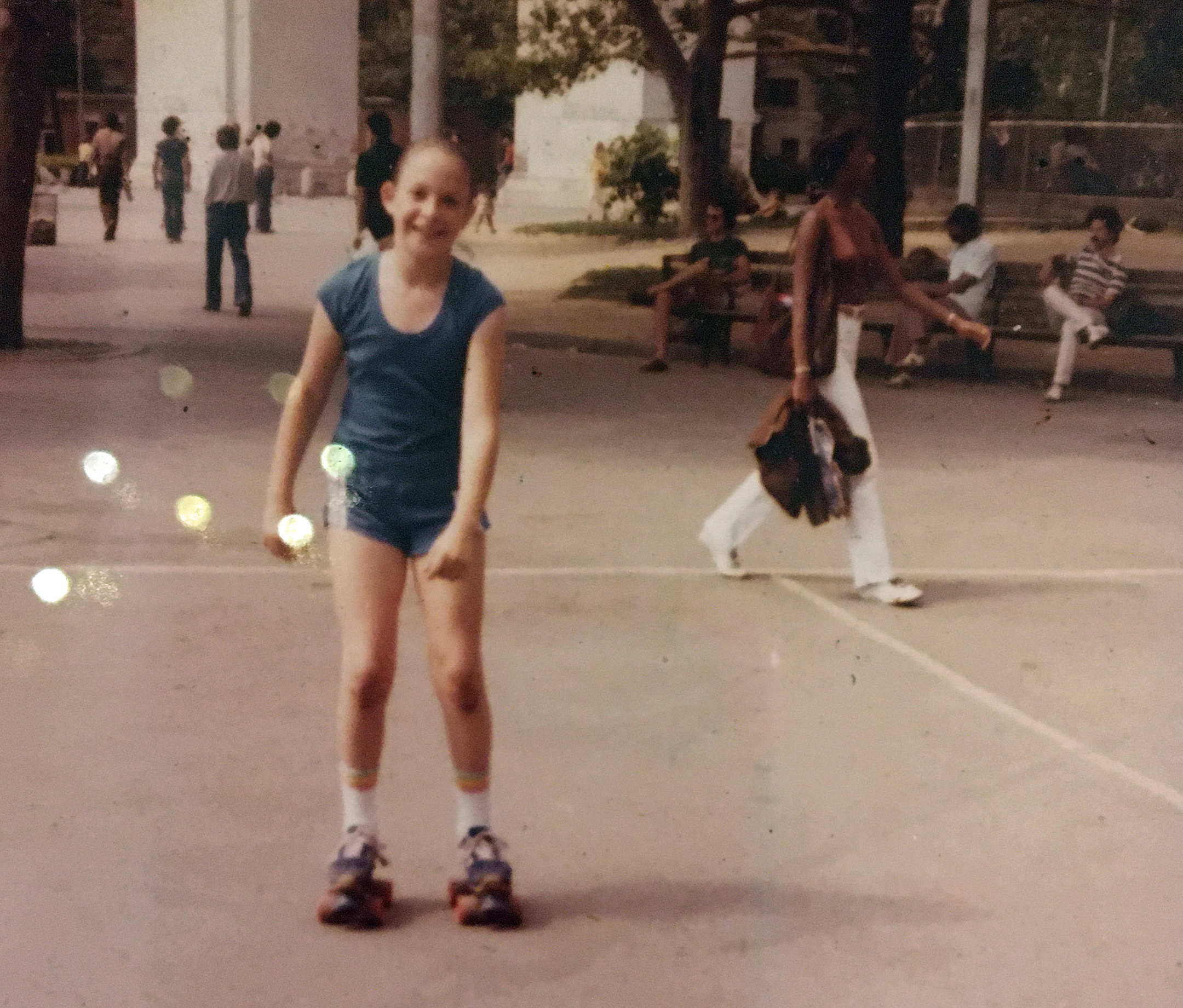A conversation about growing up in SoHo between Tina Cane and Sasha Baguskas, life-long friends who met each other in 4th grade at PS 41, circa 1978. They discuss loft living, rollerskating, rats, and much more.
TC: When did your mom, Harriet Shorr, and Jim Long, move to Mercer St.? Where were they coming from and what led them to Soho?
SB: I moved to SoHo in 1975 (or maybe it was 1976) from Pennsylvania. My mother was born in Brooklyn and grew up in Seagate. She left New York to go to college in Pennsylvania and then grad school in Connecticut. She got a job teaching painting and running the art gallery at her undergraduate alma mater, so my first years were spent there (I was born in Philadelphia.) When my mom didn’t get tenure at the college, she decided to pack it in and move back to New York, where she could pursue her painting career. My mom always said to me New York was where you should be if you wanted to be in the arts.
My mom had $10,000 when we moved. I am not sure how she and Jim found the loft on Mercer Street. I remember going into the loft and being so dismayed at what I saw: a warren of small rooms and garbage bags covering the skylight and also the windows in the front and back. I couldn’t tell how large the space was, and it seemed so dreary and run down. I hated it. We lived for I don’t know how long at my mom’s friend Janet’s place, on Prince Street, and then with her old school friend Gloria, on 20th Street and 8th Avenue or thereabouts. Now I can’t imagine how Gloria could have hosted us, a family of four (there was my older sister, Ruth, too) in her small New York apartment. I remember she had two kids who were older than us. Jim renovated the loft while we lived at these other places, and me and my sister went to PS 41, on 11th Street and Sixth Avenue.

TC: P.S.41 indeed. That’s where we met. And yes, New York was the place you had to be if you wanted to be an artist. I have a lot of memories of the artists in your midst. Talk a little about that community back then.
My mom was a still-life painter and Jim was an abstract painter. All of their friends were artists. They would come over for dinner, and I would listen to them talk about art and the art world. I remember in particular once when my mom and Rackstraw [Downes]were talking about color (it was a very specific discussion, something along the lines of how to mix a certain green maybe), and it wasn’t a conversation about politics or books, which usually were the other topics of discussion. I realize now, thinking back, that they were talking about craft. My mother was a great colorist.
There was so much I took for granted growing up, and so few questions I asked of her about being a painter. She died four years ago and while I have her paintings and there is a book she wrote (The Artist’s Eye), I wish I had taken the time to really ask about her work. She had her studio at the front of the loft, where the best light was since she only painted by natural light. I can still see her in my mind’s eye, standing at the easel with her left hand holding the paintbrush to the canvas and her body slightly leaning forward.

The loft once it was fixed up, was pretty nice. Nearly 2,500 square feet with ceiling-high windows at the front and the back (east and west facing) and a big skylight in the middle. My sister and I shared a bedroom at the back, and my mom and Jim slept out in the living area, which was basically the kitchen and living room combined. As I mentioned before, my mom’s studio was at the front of the loft and Jim had his studio in between hers and the living space. We had a chain-pull toilet in the bathroom, and an old stove in the kitchen. It wasn’t so bad.
Me and my sister roller skated in the loft. We also went to the Roxy skate rink and we skated on the dilapidated West Side Highway. We skated in Washington Square Park. My grandmother moved from Seagate and rented an apartment at 2 Fifth Avenue so she could be closer to us. We would walk to her house from school to hang out and eat snacks and watch television, and then walk home through Washington Square around early evening time, when my mom would be getting home from her job at Purchase College, where she taught painting. (She would carpool with other artist-teachers.)
During the summer, we’d swim at the Carmine Street Pool or the Thompson Street Pool. We also went to Jones Beach and Riis Park, to the beaches. We’d play handball at Thompson Street and get candy at Mary’s candy store on Thompson Street. There was sort of a divide, geographically, between the east side of West Broadway and the west side of the street. My sister once told me that there was a stand-off between us (the east side of West Broadway girls) and some girls from the west side, and I don’t remember it but apparently it got a little heated. Maybe someone threw a can. Once a kid named Yogi chased me down Thompson Street trying to hit me on my head with a Wiffle bat.
I remember when Etan Patz went missing. I am not sure how we were told, but I knew about it. I didn’t really understand at the time what had happened. I don’t remember if my mom took us to school on the bus or not afterwards; I bet she did. It was a tragedy and there’s still a quiet sadness that lingers along Prince Street.
I didn’t know that where we lived or how we lived was unique or different or special at the time. I had friends who lived in lofts (Jenny lived in Tribeca, and Khairah lived on Broadway), and friends who lived in doorman apartment buildings and tenement walk-ups. It was only later, when I moved away and went to college, that people would comment on how growing up in a loft (and in SoHo) was different. I suppose it’s all relative. The way that people lived who didn’t live in lofts (or in SoHo) seemed exotic to me. I wonder now if all the kids who grew up in SoHo wanted to live their adult lives in lofts, or in houses or apartments with rooms. Personally, now I like rooms.

TC: Let’s start with the key in the sock. Elaborate.
SB: The key in the sock! I had forgotten about that. We only had access to the stairs and not the elevator (which was a freight elevator solely used by the rag bale recycling business) and we lived five stories up, on the top floor. The bales were stored on all the floors except ours and the fourth. (The building was a “duplex”, so there were two sides and so though the building was five stories, with the two sides there were actually ten and the freight elevator shaft was in between and opened to both sides of each floor.)
The flight of stairs was a straight shot up to the fourth landing and then there was a turn, a short hallway, then another turn to the last flight of stairs that led to our loft. We ran up and down those stairs so many times in a day. I think all those years of stair climbing probably has been beneficial to my health! The other people I knew who lived in lofts had the same stairs-only option though I think those who owned their lofts had access to their elevators…anyway, this is all leading to the key in the sock! Which was a pretty simple solution for letting in people who came to visit. It was easier to throw the key wrapped in a sock down to the front door than to run down the stairs. We didn’t have a bell so visitors would have to yell up. I would stand on the fire escape and throw the key and watch it plummet and land with a thunk on the sidewalk. The visitor would have to look up to make sure it wouldn’t hit them in the head. I had always heard that if you threw a penny off the Empire State Building and it hit someone on the head, they would die. I really did think throwing the key was a pretty normal procedure.
TC: Talk about the rats.
SB: There are so many rats in New York. More than the human population, I hear. And they are immune to every kind of poison—they have evolved to live through a nuclear disaster! When I was growing up in SoHo, I saw lots of them. Especially on garbage night. We’d put our garbage bags out on the sidewalk and you could see mounds of black plastic every few yards along the block. If I was coming home in the evening, or late at night, they’d scatter away from the piles. Even on non-garbage nights they’d run across the sidewalk, across the street. I’d always scream. No matter how many times I’d see them, it was always scary.
The summer of my fifteenth year, I went to Israel to live on a kibbutz. I wanted to see how that system of communal life worked; I was a lefty sort of teenager (and still am, as an adult!). The night before my flight, as I was lying in bed, I heard a noise. I looked up, and right on my desk was a very large rat, on its hind legs, eating something, like a squirrel might. I screamed! I ran and woke my mom. This had never happened before, we had never had a rat in the loft. Jim found that a hole in the brick wall that had been blocked was chipped away, so we figured this was the entry for the rat. He blocked it up again that night though I slept on a chair in the living room/den with my legs curled up underneath me; I am not sure I slept very much that night. And I was so relieved to be going away for the whole summer! Away from the rats!
TC: As teenagers in the 1980s, who spent hours hanging around West Broadway, even we saw and sensed Soho’s gradual transformation from an artist neighborhood to a high-end shopping district. Having lived in San Francisco for decades now, what are your thoughts on gentrification and the value of protecting artist communities?
Is it possible or is their eventual dissolution inevitable?
We were very protective of our neighborhood. The tourists coming in were like an invasion. I honestly can’t remember why the tourists first came, there weren’t many stores, but there were art galleries and maybe some of those first visitors were coming for the art but eventually the tourists were seemingly only shoppers. And then it became a mutually beneficial relationship between the shops and the tourists—more stores opened, more tourists came, and people who were not artists wanted to live in lofts, and everything went bananas. There are a few artists left in SoHo, I think—my mom’s friends who owned their lofts are still there but I bet anyone who was renting and not protected by the Artists in Residence/Loft Law (as our loft is) had to leave long ago. Our street was one of the last to get fancified—but eventually it did. The Mercer Hotel opened at some point which brought in more richness—that building was empty for as long as I can remember growing up, and it was always rumoured that it would be a hotel, but it didn’t happen until long after I had moved. When the post office got sucked up and spat out to nowhere and replaced by the Apple store, you knew the neighborhood was pretty much a lost cause. And eventually things got wacko east of Broadway, more stores and crazy rents for tenement apartments.
The big beautiful buildings in SoHo and Tribeca that once housed light manufacturing were perfect places for artists to live and work. I do believe everyone should have a comfortable place to live, but if you are not an artist and you don’t need a studio, you shouldn’t take away that opportunity from someone who has less but needs the space for their work, their livelihood. I’ve lived in San Francisco longer now than I did growing up in New York, and gradually this city too has become very expensive for any regular people to live in. San Francisco has very good tenant protections (which I benefit from) but that is limited. I’ve read that around 70% of the artists who lived in San Francisco have had to move because of the high rents. I don’t think people who move to places because of the artists and the neighborhood vibe understand that their privilege of having deep pockets displaces the people who created the vibe that attracted them in the first place, and then the neighborhood goes to shit. I am presenting this in a very black and white way, but that’s how it seems. Once you take away the artists and the regular people in a city, it becomes something else. And then is it a city?
Born and raised in New York City, Tina Cane serves as the Poet Laureate of Rhode Island where she is the founder and director of Writers-in-the-Schools, RI. Her poems and translations have appeared in numerous publications, including The Literary Review, Spinning Jenny, Tupelo Quarterly, Jubliat and The Common. She also co-produces, with Atticus Allen, the podcast, “Poetry Dose.”
Sasha Baguskas was born in Philadelphia and raised in New York. After graduating from college, she moved to Portland, Oregon and then moved to San Francisco in 1993 where she has lived ever since. Since 1995 she has worked at Crown Point Press, publisher of fine art etchings. Sasha lives in the outer Sunset neighborhood of San Francisco with her 16-year old son, Oliver, and her partner, Jim Hopper.

